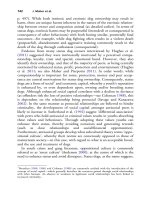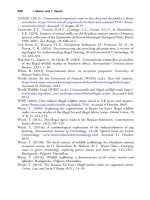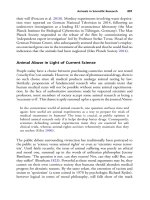The palgrave international handbook of a 142
Bạn đang xem bản rút gọn của tài liệu. Xem và tải ngay bản đầy đủ của tài liệu tại đây (28 KB, 1 trang )
Status Dogs
133
The focus of this chapter is on the harms caused to dogs through their owner’s
behaviour and their being labelled as ‘status’ or ‘dangerous’ by their owners, the
government and mainstream society. The chapter explores the nature of status
dog ownership in the UK. The discussion is informed by four research projects
conducted by the authors: (1) Pierpoint and Maher’s (2010) analysis of convictions for animal abuse, (2) Maher and Pierpoint’s (2011) small-scale qualitative
research on the use of dogs by young people, involving interviews and observation of young people and youth justice and animal welfare professionals, (3)
Hughes, Maher and Lawson’s systematic literature review and qualitative fieldwork with young people variously involved with the status dogs problem
(Hughes et al. 2011), and (4) Lawson’s (forthcoming) 25 semi-structured expert
interviews on anti-social and criminal use of dogs. We consider the nature of
abuse, detailing harms ranging from the breeding, selling, training and habitation of the dog, to the subsequent abandonment and killing of these ‘companions’. It must be noted that while the authors recognise there are considerable
harms to humans, as a result of antisocial and aggressive dog behaviour in terms
of intimidation and physical injury, and the links between status dog ownership
and gang/criminal activity, the remit of this book is on the animal abuse and
consequently these issues are not addressed here (see further Hughes et al. 2011
and Barnes et al. 2006).
Next, the prevalence of the status dog phenomenon in the UK and the
problems with measurement are discussed. Thereafter, criminological theories—labelling theory, subcultural theory and differential association—are
considered to explain the desire for, and harms experienced by, status dogs.
Following this, societal reactions to the status dog phenomenon are considered, with particular focus on legislation and intervention approaches. We
start with defining the key terms often used incorrectly and interchangeably.
Key Terms
Status Dogs
Although the term is rarely employed now by the RSPCA (Lawson, forthcoming), their briefing on status dogs referred to them as dogs
used in an aggressive or intimidating way towards the public and other animals,
often involving the fighting of these dogs…These dogs are traditionally, but
not exclusively, associated with young people on inner city estates and those
involved in criminal activity (RSPCA 2010, p. 1).









